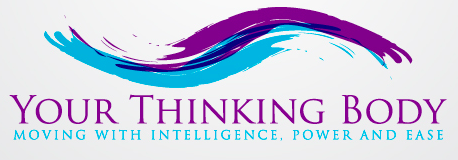thigh.
3. Now gently place your right hand on the top of your head with your right elbow pointing to your right. Make it comfortable for yourself!-Slowly, much more slowly than you usually move, begin tipping your head to your left so that your left ear moves toward your left shoulder. Notice if your shoulder tends to move as well. Do not bring your shoulder up toward your ear.-Go a short distance. Move only as much as is pleasurable! You will notice that your right elbow moves upward as you bring your left ear toward your shoulder. Come back to sitting with your hand still on your head. -With utmost attention to your feeling, do this small gentle tipping movement a few times. Be sure you continue facing forward so that there is no twisting to either side. Always look forward. This may mean you don’t move as far. That’s OK. Go a shorter distance and enjoy the ease of intentionally moving slowly.Can you tell if your spine moves? Where and how does it move? Or maybe it doesn’t move. Notice also if there is any movement in your chest, or ribs. Maybe you will feel your pelvis move. Is one side of your ribs are easier to feel than the other? Maybe not. Does your weight shift more on to one hip? Which one?4. Put you right hand on your right thigh and rest as you sit in the chair.5. Return to the front of your chair with your feet on the floor below your knees.6. Place your right hand on your right thigh and your left hand on the top of your head. Listen carefully to the next direction.7, Again, tip your left ear to the left. (This is not a symmetrical lesson.)As you repeat this movement do you notice your spine lengthening or moving? Does your weight move on to one hip more than the other? Notice. What is happening with your ribs? Chest? Spine?
8. Now stay tipped to your left with your left hand on your head. While you are askew this way, begin lifting one hip a bit off the chair. Then lift your other hip a bit off your chair. Do this a few times.
9. Return slowly to sitting in the middle and bring your hand down to rest on your thigh. Sit in your neutral position.
How does sitting feel now? Perhaps you feel taller. Perhaps not. Do you notice yourself sitting more easily?
Does your breathing seem freer?
10. Stand and see if standing feels any different. Walk, perhaps you feel changes.
Whether you have noticed many differences, none, or a few, this work is worth doing. It helps you to become aware of your feeling of yourself. This skill has many uses. More about that in future Newsletters!



No comments yet.